Summer in the Arctic is drawing to a close, and sea ice extent is likely to remain higher than in recent years. Several polynyas have formed poleward of 85 degrees North within the pack as well as areas near the thin ice edge. While some thin ice can still be found in the Northern Sea Route and southern Northwest Passage, both appear to be largely open. The northern deep water Northwest Passage route also appears to be largely open. Antarctic sea ice has remained at record or near-record low extent for the month.
Overview of conditions
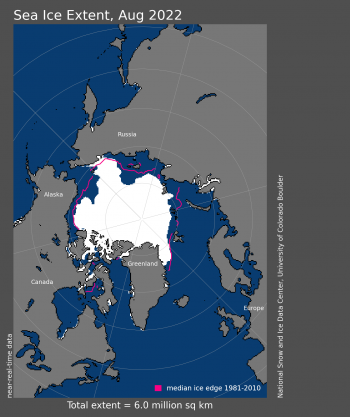
Figure 1a. Arctic sea ice extent for August 2022 was 5.99 million square kilometers (2.31 million square miles). The magenta line shows the 1981 to 2010 average extent for that month. Sea Ice Index data. About the data
Credit: National Snow and Ice Data Center
High-resolution image
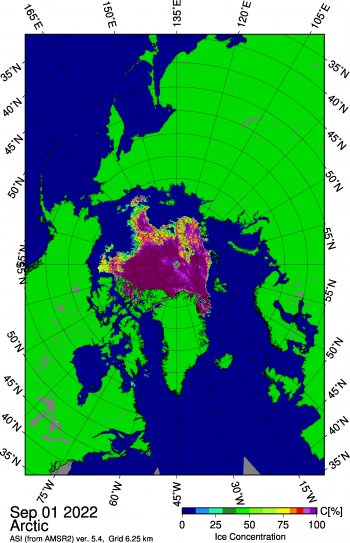
Figure 1b. This map shows open water within the ice pack, known as a polynya, poleward of 85 degrees North. Sea ice concentration data are from Advanced Microwave Scanning Radiometer 2 (AMSR2) imagery.
Credit: University of Bremen
High-resolution image
Average Arctic sea ice extent for August 2022 was 5.99 million square kilometers (2.31 million square miles), ranking thirteenth lowest in the satellite record (Figure 1a) and 1.21 million square kilometers (467,000 square miles) below the 1981 to 2010 average. Ice extent tracked below the interdecile range of the satellite record through the month, and the total ice loss through the month was 1.79 million square kilometers (691,000 square miles). Extent remained particularly low in the Laptev and Chukchi Seas. As seen in the Advanced Microwave Scanning Radiometer 2 (AMSR2) imagery, areas of low concentration ice that started to develop poleward of 85 degrees North in July developed into areas of open water within the pack ice, or polynyas (Figure 1b). These features are much further north than is typical. On the Atlantic side, the ice edge remained north of Svalbard and Franz Josef Land, continuing the pattern seen for most of the season.
The rate of decline for Arctic sea ice extent was near average for most of the month at about 60,000 square kilometers (23,000 square miles) per day, but briefly increased late in the month to near 85,000 square kilometers (33,000 square miles) per day. During the second half of August, ice loss was mostly in the East Siberian Sea and the northern Chukchi Sea.
Conditions in context
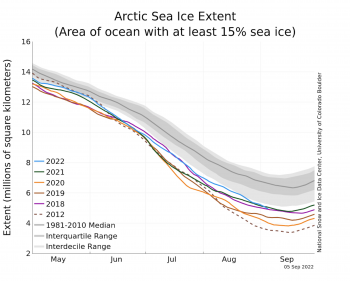
Figure 2a. The graph above shows Arctic sea ice extent as of September 05, 2022, along with daily ice extent data for four previous years and the record low year. 2022 is shown in blue, 2021 in green, 2020 in orange, 2019 in brown, 2018 in magenta, and 2012 in dashed brown. The 1981 to 2010 median is in dark gray. The gray areas around the median line show the interquartile and interdecile ranges of the data. Sea Ice Index data.
Credit: National Snow and Ice Data Center
High-resolution image
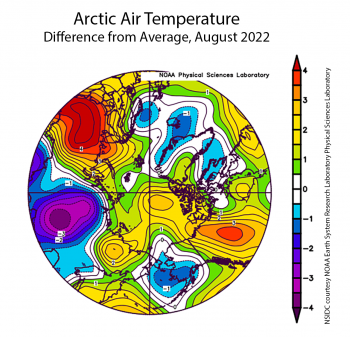
Figure 2b. This plot shows the departure from average air temperature in the Arctic at the 925 hPa level, in degrees Celsius, for August 2022. Yellows and reds indicate higher than average temperatures; blues and purples indicate lower than average temperatures.
Credit: NSIDC courtesy NOAA Earth System Research Laboratory Physical Sciences Laboratory
High-resolution image

Figure 2c. This plot shows average sea level pressure in the Arctic in millibars for August 2022. Yellows and reds indicate high air pressure; blues and purples indicate low pressure.
Credit: NSIDC courtesy NOAA Earth System Research Laboratory Physical Sciences Laboratory
High-resolution image
Air temperatures over the central Arctic Ocean at the 925 hPa level (about 2,500 feet above the surface) were generally 1 to 3 degrees Celsius (2 to 5 degrees Fahrenheit) above 1991 to 2020 reference period (Figure 2b). Conditions in the Barents Sea and southern Kara Sea were particularly warm, ranging up to 4 degrees Celsius (7 degrees Fahrenheit) above average. However, temperatures over the Bering Sea and the Denmark Strait (between Iceland and Greenland) were slightly below average.
The sea level pressure pattern for August favored winds from the south and west toward Europe, and cool air moving out of the Arctic over the Laptev Sea coast in Siberia (Figure 2c). Low air pressure over Alaska led to winds from the north over the Bering Sea, consistent with the below-average temperatures in that area.
While the summer melt season is nearly over, the forecast for early September is for above-average air temperatures over the central Arctic. Coupled with the thin and dispersed sea ice cover, and residual heat in the upper ocean where low sea ice concentration permitted some solar warming earlier in the summer, we may see an expansion of the polynyas near the North Pole for a time in early September.
August 2022 compared to previous years
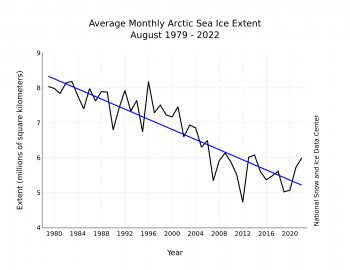
Figure 3. Monthly August ice extent for 1979 to 2022 shows a decline of 10.1 percent per decade.
Credit: National Snow and Ice Data Center
High-resolution image
The downward linear trend in August sea ice extent over the 44-year satellite record is 72,500 square kilometers (28,000 square miles) per year, or 10.1 percent per decade relative to the 1981 to 2010 average. Based on the linear trend, since 1979, August has lost 1.7 million square kilometers (656,000 square miles). This is equivalent to about the size of Alaska.
North by northwest
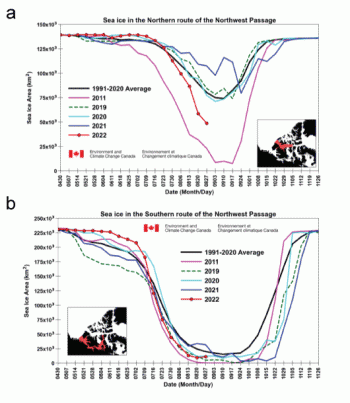
Figure 4. These graphs show sea ice area for the recent summer season in the two most common paths of the Northwest Passage through the Canadian Archipelago. The top graphic shows a time series plot of total sea ice area for 2022, 2021, 2020, 2019, 2011, and the 1991 to 2020 average within the northern route of the Northwest Passage. The lower graphic shows sea ice area for the southern route for the same time period.
Credit: Data from the Canadian Ice Service provided by our colleague Steve Howell of Environment and Climate Change Canada (ECCC)
High-resolution image
As of the August 27, sea ice area in the northern (deep water) route of the Northwest Passage (NWP) was tracking well below the 1991 to 2020 average (Figure 4, top) but above 2011 record low conditions. High concentrations of multi-year ice were still present in some areas. Ice area in the southern route (Amundsen’s route in 1905) was also tracking well below the 1991 to 2020 average (Figure 4, bottom). The southern route was almost sea ice-free as of late August except for some low concentration first-year ice in the vicinity of Victoria Strait. The northern route of the Northwest Passage is considered to eventually be more viable for shipping. Mudruyk and team discuss the impact of the current warming trend on potential shipping through the Canadian Arctic, noting large increases in navigability of the NWP and other parts of the Arctic with 2 degrees Celsius (4 degrees Fahrenheit) global warming above pre-industrial levels. Even non-ice strengthened vessels may have a 15-day season of operation in the northern NWP according to their study. By contrast, the Northern Sea Route has been nearly free of ice for at least part of August and September for most of the past decade, and it is used increasingly for shipping both within the Russian Arctic and from Arctic ports to the Far East.
Arctic sea surface temperatures
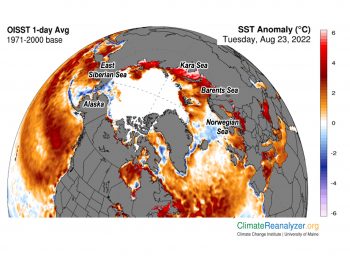
Figure 5. This map shows sea surface temperatures (SSTs) for the Arctic and much of the northern Atlantic and Pacific Oceans, as well as the peripheral seas in the northern hemisphere. Data shows SSTs on August 23, 2022. Extremely warm ocean conditions exist along parts of the Siberian coast, but cooler than average conditions are found in the Bering Sea and Norwegian Sea.
Credit: Climate Reanalyzer, University of Maine
High-resolution image
According to our colleague, Mike Steele, at the University of Washington Polar Science Center, Pan-Arctic sea surface temperatures (SSTs) in late August are generally above average relative to the 1971 to 2000 reference period (Figure 5). However, Alaskan Arctic SSTs this year are lower than average, likely because the relatively late sea ice retreat limited warming through solar heating. Meanwhile, SSTs on the Russian continental shelf from the eastern Barents Sea to the western East Siberian Sea are far above average. Ice retreat was early there, allowing the upper ocean to warm more strongly through solar heating, with advection of warm air in the southern Barents and Kara Seas (Figure 2 in the August 17 post) perhaps also playing a role.
Reference
Mudryk, L., J. P. Dawson, S. E. L. Howell, C. Derksen, T. Zagon, and M. Brady. 2021. Impact of 1°, 2°, and 4°C of global warming on ship navigation in the Canadian Arctic. Nature Climate Change,11, 673–679, doi:10.1038/s41558-021-01087-6.

